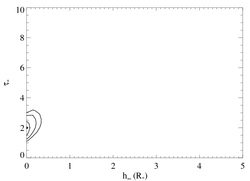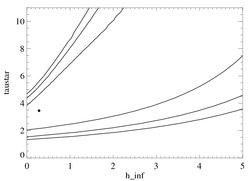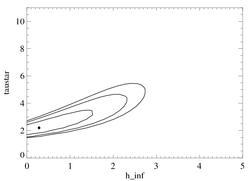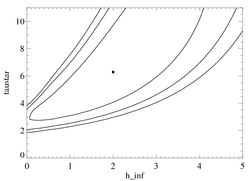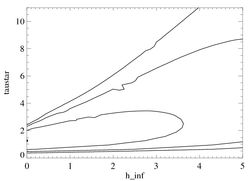ζ Pup: Chandra HETGS line-profile analysis
These fits: non-porous, aniso-, and iso- porous (with hinf fixed at 0.5, 1, & 5) complement the initial work we did on the RGS spectrum.
The data shown here were reduced by David, several years ago, for the analysis that was published in Cohen et al. (2010). We use the wavelength ranges and continuum levels determined in that analysis. The effective exposure time is 68 ks; much shorter than the RGS effective exposure time. But the background is much lower, the spectral resolution is higher. The wavelength coverage overlaps, but there are some differences -- Chandra better at short wavelengths, XMM at long wavelengths. The two datasets are complementary.
The entire HETGS spectra
MEG

HEG

Line-by-line results
Below are the systematic fits of different model cases, presented in the same order and format as for the RGS data. Note that here, there are two plots for most lines: the Medium Energy Grating (MEG) data and the High Energy Grating (HEG) data. They were fit simultaneously (i.e. the model shown on each is the same -- with parameters listed to the right of the plots -- though they may look different because of the different spectral responses, binning, and effective area of the two different gratings). Also, here we fit the continuum separately from the line and use the C statistic (as described in Cohen et al. 2010).
The lines we fit and present here are:
Fe XVII @ 15.014 A
O VIII (Ly-alpha) @ 18.969 A
Ne X (Ly-alpha) @ 12.134 A
Fe XVII @ 16.780 A
Mg XII (Ly-alpha) @ 8.421 A
None of the other lines are strong enough and unblended enough to provide meaningful constraints on porosity (though 11 other lines and line complexes were fit and presented in Cohen et al. 2010 because there we were only looking at non-porous models). These same lines, with the exception of Mg XII (too weak), were fit in the RGS data and results are presented on the RGS results page. Several other lines in the RGS spectrum are fit, too.
15.014 Angstroms: Fe XVII
Non-porous
MEG
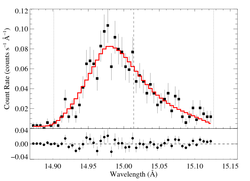
HEG
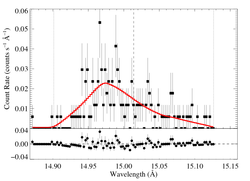
|
[14.87:15.13]
vinf = 2250
β = 1
powerlaw continuum, n = 2; norm = 1.71e-3
q = 0
hinf = 0
taustar = 1.94 +/- (1.61:2.26)
Ro = 1.55 +/- (1.43:1.67)
norm = 5.24e-4 +/- (5.07e-4:5.48e-4)
C = 280.83 for N = 308
|
Compare these results to the analogous model fit to the same line in the XMM RGS spectrum. The agreement is very good. (Comparing the confidence limits as well as the best-fit parameter values is interesting. Though, note the continuum normalizations do not agree all that well.)
Anisotropic porosity
We test several values of hinf, using anisotropic porosity, employing the Rosseland (inverse) bridging law. When the porosity length is treated as a free parameter, hinf=0 was preferred, with the non-porous fit parameters recovered (i.e. the data do not favor anisotropic porosity).
hinf = 0.5
MEG

HEG
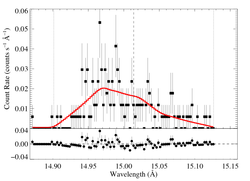
|
[14.87:15.13]
vinf = 2250
β = 1
powerlaw continuum, n = 2; norm = 1.71e-3
q = 0
hinf = 0.5 (frozen)
taustar = 2.51 +/- (2.11:3.19)
Ro = 1.61 +/- (1.47:1.69)
norm = 5.23e-4 +/- (5.05e-4:5.46e-4)
C = 293.94 for N = 308
|
hinf = 1
MEG

HEG
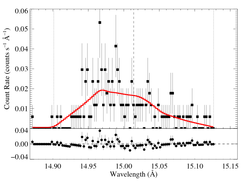
|
[14.87:15.13]
vinf = 2250
β = 1
powerlaw continuum, n = 2; norm = 1.71e-3
q = 0
hinf = 1.0 (frozen)
taustar = 3.02 +/- (2.37:3.86)
Ro = 1.65 +/- (1.55:1.75)
norm = 5.22e-4 +/- (5.04e-4:5.45e-4)
C = 303.80 for N = 308
|
hinf = 2
MEG
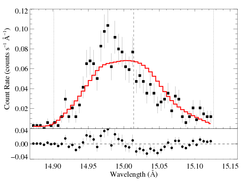
HEG
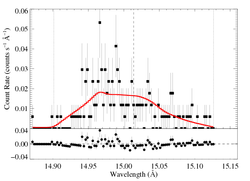
|
[14.87:15.13]
vinf = 2250
β = 1
powerlaw continuum, n = 2; norm = 1.71e-3
q = 0
hinf = 2.0 (frozen)
taustar = 3.76 +/- (2.76:5.32)
Ro = 1.74 +/- (1.63:1.83)
norm = 5.22e-4 +/- (5.04e-4:5.45e-4)
C = 317.39 for N = 308
|
hinf = 5
MEG
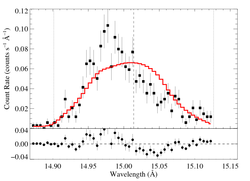
HEG
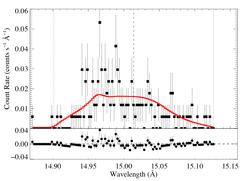
|
[14.87:15.13]
vinf = 2250
β = 1
powerlaw continuum, n = 2; norm = 1.71e-3
q = 0
hinf = 5.0 (frozen)
taustar = 6.95 +/- (3.94:12.27)
Ro = 1.84 +/- (1.73:1.95)
norm = 5.21e-4 +/- (5.03e-4:5.44e-4)
C = 338.35 for N = 308
|
All four of these anisotropic porosity models (hinf = 0.5, 1, 2, 5) produce poor fits from a formal statistical point of view; though the hinf = 0.5 model is only rejected at something like the 99.9% level, with Delta C ~ 13.
Confidence limits in taustar-hinf parameter space
Isotropic porosity
Here we fit models with isotropic porosity, for the same set of fixed terminal porosity length values. Again, when hinf is allowed to be free, a best-fit value of zero is found, indicating the non-porous models are favored.
hinf = 0.5
MEG

HEG
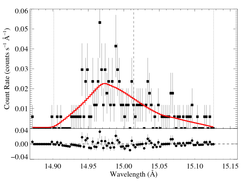
|
[14.87:15.13]
vinf = 2250
β = 1
powerlaw continuum, n = 2; norm = 1.71e-3
q = 0
hinf = 0.5 (frozen)
taustar = 2.18 +/- (1.79:2.60)
Ro = 1.58 +/- (1.48:1.69)
norm = 5.24e-4 +/- (5.07e-4:5.48e-4)
C = 282.01 for N = 308
|
hinf = 1
MEG

HEG

|
[14.87:15.13]
vinf = 2250
β = 1
powerlaw continuum, n = 2; norm = 1.71e-3
q = 0
hinf = 1.0 (frozen)
taustar = 2.46 +/- (1.99:3.00)
Ro = 1.61 +/- (1.48:1.69)
norm = 5.24e-4 +/- (5.07e-4:5.48e-4)
C = 283.35 for N = 308
|
Note: with hinf = 1, taustar has increased by 27 percent.
hinf = 2
MEG
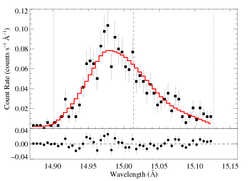
HEG
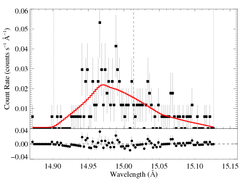
|
[14.87:15.13]
vinf = 2250
β = 1
powerlaw continuum, n = 2; norm = 1.71e-3
q = 0
hinf = 2.0 (frozen)
taustar = 3.09 +/- (2.43:3.98)
Ro = 1.65 +/- (1.56:1.73)
norm = 5.24e-4 +/- (5.06e-4:5.48e-4)
C = 286.44 for N = 308
|
hinf = 5
MEG

HEG

|
[14.87:15.13]
vinf = 2250
β = 1
powerlaw continuum, n = 2; norm = 1.71e-3
q = 0
hinf = 5.0 (frozen)
taustar = 5.70 +/- (4.04:8.45)
Ro = 1.74 +/- (1.65:1.81)
norm = 5.23e-4 +/- (5.05e-4:5.46e-4)
C = 297.17 for N = 308
|
Here, for the isotropic porosity models, the first two models (with hinf = 0.5 and 1.0) are only very slightly worse than the non-porous model fit. Statistically, they are indistinguishable (the hinf = 1 model, with Delta C ~ 3 is only rejected with about 90% confidence). Note that the actual taustar values found for these models tell us something -- they are only slightly higher than the non-porous best-fit model, implying that isotropic porosity has very little effect on the line profiles for porosity lengths less than unity. But, the high porosity model, with (hinf = 5) does produce a substantially worse fit -- rejection probability >99.9% (and a rather high value of taustar).
Note that qualitatively, the RGS results for this line and these seven different models are similar. The best-fit taustar values for the anisotropic porosity models tend be higher in the RGS data fitting than in Chandra.
Confidence limits in taustar-hinf parameter space
Given the isotropic porosity model, and allowing hinf now to be a free parameter, along with the others, we can examine a 2-D grid of chi square values (or in this case, C values). The global best-fit model is denoted by the filled circle and the contours represent the formal 68%, 95%, and 99% confidence limits. (Note that Ro, along with the normalizations, is still a free parameter here even though it is not shown in this parameter space).
Details of the fitting are in the xspec log.
18.969 Angstroms: O VIII
The HEG count rate is so low at these long wavelengths, that we only fit the MEG spectrum for this line. Even the MEG doesn't have the greatest signal-to-noise.
Non-porous
MEG
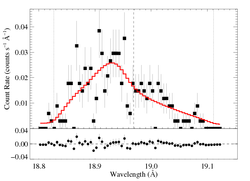
|
[18.80:19.13]
vinf = 2250
β = 1
powerlaw continuum, n = 2; norm = 2.40e-3
q = 0
hinf = 0
taustar = 3.00 +/- (2.46:3.54)
Ro = 1.22 +/- (1.01:1.59)
norm = 3.70e-4 +/- (3.45e-4:3.99e-4)
C = 150.88 for N = 130
|
Compare these results to the analogous model fit to the same line in the XMM RGS spectrum. The agreement is very good.
Anisotropic porosity
When the porosity length is treated as a free parameter, hinf=0 was preferred, with the non-porous fit parameters recovered (i.e. the data do not favor anisotropic porosity).
hinf = 0.5
MEG

|
[18.80:19.13]
vinf = 2250
β = 1
powerlaw continuum, n = 2; norm = 2.40e-3
q = 0
hinf = 0.5 (frozen)
taustar = 4.26 +/- (3.10:5.44)
Ro = 1.43 +/- (1.22:1.74)
norm = 3.70e-4 +/- (3.44e-4:3.98e-4)
C = 152.91 for N = 130
|
hinf = 1
MEG
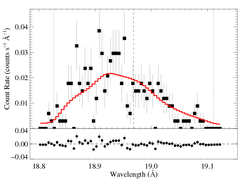
|
[18.80:19.13]
vinf = 2250
β = 1
powerlaw continuum, n = 2; norm = 2.40e-3
q = 0
hinf = 1.0 (frozen)
taustar = 5.22 +/- (3.61:7.39)
Ro = 1.57 +/- (1.34:1.83)
norm = 3.70e-4 +/- (3.43e-4:4.00e-4)
C = 155.06 for N = 130
|
hinf = 2
MEG

|
[18.80:19.13]
vinf = 2250
β = 1
powerlaw continuum, n = 2; norm = 2.40e-3
q = 0
hinf = 2.0 (frozen)
taustar = 7.83 +/- (4.90:11.75)
Ro = 1.66 +/- (1.46:1.91)
norm = 3.62e-4 +/- (3.43e-4:4.00e-4)
C = 158.30 for N = 130
|
hinf = 5
MEG

|
[18.80:19.13]
vinf = 2250
β = 1
powerlaw continuum, n = 2; norm = 2.40e-3
q = 0
hinf = 5.0 (frozen)
taustar = 21.10 +/- (10.60:37.02)
Ro = 1.74 +/- (1.54:1.97)
norm = 3.57e-4 +/- (3.42e-4:3.99e-4)
C = 164.98 for N = 130
|
The hinf = 5 fit can be statistically rejected (compared the non-porous model, at > 99.9% confidence), but the lower porosity length fits are only marginally worse than the non-porous model fit.
Isotropic porosity
Here we fit models with isotropic porosity, for the same set of fixed terminal porosity length values. When hinf is allowed to be free, a best-fit value of 0.21 is found, but it is statistically indistinguishable from the best-fit non-porous model (i.e. hinf = 0; see contour plot of confidence limits at the bottom of this section).
hinf = 0.5
MEG
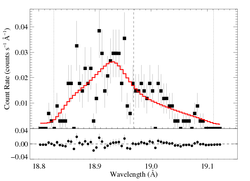
|
[18.80:19.13]
vinf = 2250
β = 1
powerlaw continuum, n = 2; norm = 2.40e-3
q = 0
hinf = 0.5 (frozen)
taustar = 3.85 +/- (2.75:4.90)
Ro = 1.32 +/- (1.12:1.70)
norm = 3.70e-4 +/- (3.42e-4:3.99e-4)
C = 150.88 for N = 130
|
hinf = 1
MEG
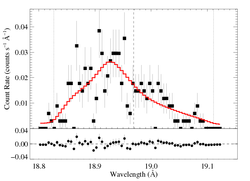
|
[18.80:19.13]
vinf = 2250
β = 1
powerlaw continuum, n = 2; norm = 2.40e-3
q = 0
hinf = 1.0 (frozen)
taustar = 4.42 +/- (2.95:6.16)
Ro = 1.45 +/- (1.22:1.79)
norm = 3.71e-4 +/- (3.42e-4:3.99e-4)
C = 151.04 for N = 130
|
Note: with hinf = 1, taustar has increased by 47 percent.
hinf = 2
MEG

|
[18.80:19.13]
vinf = 2250
β = 1
powerlaw continuum, n = 2; norm = 2.40e-3
q = 0
hinf = 2.0 (frozen)
taustar = 5.85 +/- (3.66:8.73)
Ro = 1.56 +/- (1.37:1.84)
norm = 3.62e-4 +/- (3.43e-4:3.99e-4)
C = 151.11 for N = 130
|
hinf = 5
MEG
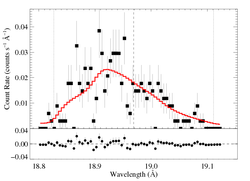
|
[18.80:19.13]
vinf = 2250
β = 1
powerlaw continuum, n = 2; norm = 2.40e-3
q = 0
hinf = 5.0 (frozen)
taustar = 13.23 +/- (7.43:21.97)
Ro = 1.69 +/- (1.54:1.90)
norm = 3.60e-4 +/- (3.43e-4:3.99e-4)
C = 152.10 for N = 130
|
Note that all these iso-porous fits are statistically good, but the taustar value of the last one is unphysically high.
Confidence limits in taustar-hinf parameter space
Given the isotropic porosity model, and allowing hinf now to be a free parameter, along with the others, we can examine a 2-D grid of ΔC values. The global best-fit model is denoted by the filled circle and the contours represent the formal 68%, 90%, and 95% confidence limits. Due to the low signal-to-noise of this line, the constraints are not very tight, but the usual increase of taustar as hinf is clearly visible.
Details of the fitting are in the xspec log.
12.134 Angstroms: Ne X
Non-porous
MEG
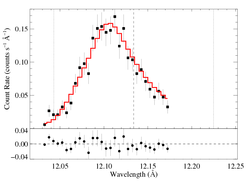
HEG
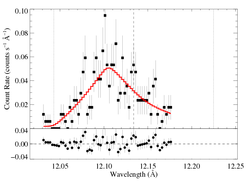
|
[12.03:12.18]
vinf = 2250
β = 1
powerlaw continuum, n = 2; norm = 1.64e-3
q = 0
hinf = 0
taustar = 2.01 +/- (1.77:2.28)
Ro = 1.45 +/- (1.37:1.58)
norm = 2.71e-4 +/- (2.62e-4:2.80e-4)
C = 191.42 for N = 176
|
Compare these results to the analogous model fit to the same line in the XMM RGS spectrum. The agreement is very good.
Anisotropic porosity
When the porosity length is treated as a free parameter, hinf=0 was preferred, with the non-porous fit parameters recovered (i.e. the data do not favor anisotropic porosity).
hinf = 0.5
MEG

HEG
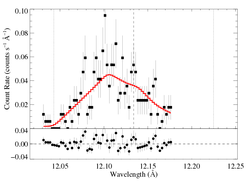
|
[12.03:12.18]
vinf = 2250
β = 1
powerlaw continuum, n = 2; norm = 1.64e-3
q = 0
hinf = 0.5 (frozen)
taustar = 2.92 +/- (2.51:3.36)
Ro = 1.49 +/- (1.40:1.58)
norm = 2.72e-4 +/- (2.63e-4:2.81e-4)
C = 208.84 for N = 176
|
hinf = 1
MEG
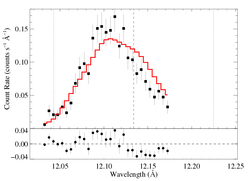
HEG

|
[12.03:12.18]
vinf = 2250
β = 1
powerlaw continuum, n = 2; norm = 1.64e-3
q = 0
hinf = 1.0 (frozen)
taustar = 3.60 +/- (2.99:4.24)
Ro = 1.56 +/- (1.48:1.64)
norm = 2.71e-4 +/- (2.63e-4:2.81e-4)
C = 223.76 for N = 176
|
hinf = 2
MEG
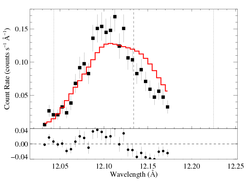
HEG

|
[12.03:12.18]
vinf = 2250
β = 1
powerlaw continuum, n = 2; norm = 1.64e-3
q = 0
hinf = 2.0 (frozen)
taustar = 5.00 +/- (3.99:6.37)
Ro = 1.65 +/- (1.56:1.72)
norm = 2.73e-4 +/- (2.64e-4:2.83e-4)
C = 245.01 for N = 176
|
hinf = 5
MEG
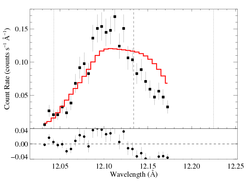
HEG

|
[12.03:12.18]
vinf = 2250
β = 1
powerlaw continuum, n = 2; norm = 1.64e-3
q = 0
hinf = 5.0 (frozen)
taustar = 11.32 +/- (7.60:17.06)
Ro = 1.77 +/- (1.66:1.87)
norm = 2.76e-4 +/- (2.67e-4:2.86e-4)
C = 277.64 for N = 176
|
All the anisotropic porosity fits can be rejected -- compared to the non-porous best fit, even the hinf = 0.5 model has Delta C ~ 17, corresponding to a rejection probability of > 99.99%.
Isotropic porosity
When hinf is allowed to be free, a best-fit value of zero is found, indicating the non-porous models are favored.
hinf = 0.5
MEG
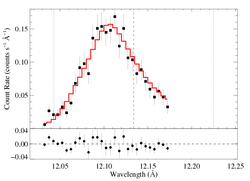
HEG
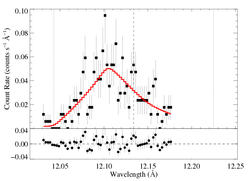
|
[12.03:12.18]
vinf = 2250
β = 1
powerlaw continuum, n = 2; norm = 1.64e-3
q = 0
hinf = 0.5 (frozen)
taustar = 2.39 +/- (2.04:2.72)
Ro = 1.49 +/- (1.41:1.59)
norm = 2.69e-4 +/- (2.62e-4:2.80e-4)
C = 191.83 for N = 176
|
hinf = 1
MEG
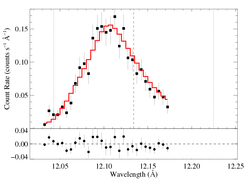
HEG

|
[12.03:12.18]
vinf = 2250
β = 1
powerlaw continuum, n = 2; norm = 1.64e-3
q = 0
hinf = 1.0 (frozen)
taustar = 2.80 +/- (2.36:3.24)
Ro = 1.51 +/- (1.44:1.60)
norm = 2.69e-4 +/- (2.61e-4:2.79e-4)
C = 192.53 for N = 176
|
Note: with hinf = 1, taustar has increased by 39 percent.
hinf = 2
MEG
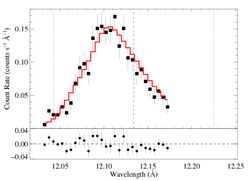
HEG
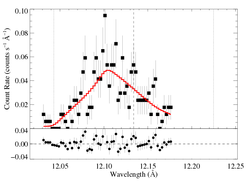
|
[12.03:12.18]
vinf = 2250
β = 1
powerlaw continuum, n = 2; norm = 1.64e-3
q = 0
hinf = 2.0 (frozen)
taustar = 3.86 +/- (3.17:4.61)
Ro = 1.54 +/- (1.48:1.61)
norm = 2.69e-4 +/- (2.61e-4:2.79e-4)
C = 194.95 for N = 176
|
hinf = 5
MEG
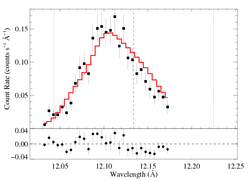
HEG
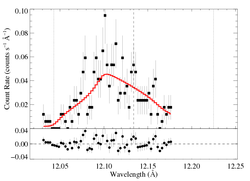
|
[12.03:12.18]
vinf = 2250
β = 1
powerlaw continuum, n = 2; norm = 1.64e-3
q = 0
hinf = 5.0 (frozen)
taustar = 9.24 +/- (7.09:12.06)
Ro = 1.61 +/- (1.55:1.67)
norm = 2.69e-4 +/- (2.60e-4:2.78e-4)
C = 208.48 for N = 176
|
The models with modest porosity (hinf = 0.5 and 1) fit the data fine, but the high porosity length model does not.
Confidence limits in taustar-hinf parameter space
The formal constraints here are pretty tight, and the increase of taustar as hinf is clearly visible.
Details of the fitting are in the xspec log.
20.910 Angstroms: N VII
This is the next line we fit on the XMM page, but in the Chandra data it is too weak to effectively constrain porosity. The non-porous model fit to the Chandra data, which agrees well with the XMM results, can be seen here.
16.780 Angstroms: Fe XVII
The HEG count rate is so low at these long wavelengths, that, while we included the HEG data in the fit, we show only the MEG spectrum for this line.
Non-porous
MEG
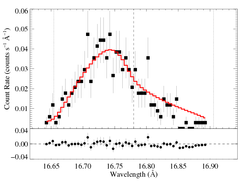
|
[16.64:16.90]
vinf = 2250
β = 1
powerlaw continuum, n = 2; norm = 2.20e-3
q = 0
hinf = 0
taustar = 3.01 +/- (2.31:3.33)
Ro = 1.01 +/- (1.01:1.60)
norm = 2.45e-4 +/- (2.28e-4:2.58e-4)
C = 174.88 for N = 308
|
Anisotropic porosity
When the porosity length is treated as a free parameter, hinf goes to zero, implying that non-porous models are favored over those with anisotropic porosity.
hinf = 0.5
MEG

|
[16.64:16.90]
vinf = 2250
β = 1
powerlaw continuum, n = 2; norm = 2.20e-3
q = 0
hinf = 0.5 (frozen)
taustar = 4.12 +/- (3.22:5.05)
Ro = 1.40 +/- (1.21:1.62)
norm = 2.40e-4 +/- (2.29e-4:2.59e-4)
C = 180.66 for N = 308
|
hinf = 1
MEG
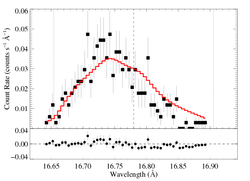
|
[16.64:16.90]
vinf = 2250
β = 1
powerlaw continuum, n = 2; norm = 2.20e-3
q = 0
hinf = 1.0 (frozen)
taustar = 5.45 +/- (4.12:6.91)
Ro = 1.43 +/- (1.34:1.68)
norm = 2.47e-4 +/- (2.29e-4:2.60e-4)
C = 185.55 for N = 308
|
hinf = 2
MEG
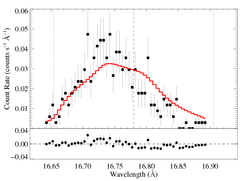
|
[16.64:16.90]
vinf = 2250
β = 1
powerlaw continuum, n = 2; norm = 2.20e-3
q = 0
hinf = 2.0 (frozen)
taustar = 8.77 +/- (6.17:12.16)
Ro = 1.58 +/- (1.43:1.75)
norm = 2.41e-4 +/- (2.29e-4:2.60e-4)
C = 193.18 for N = 308
|
hinf = 5
MEG

|
[16.64:16.90]
vinf = 2250
β = 1
powerlaw continuum, n = 2; norm = 2.20e-3
q = 0
hinf = 5.0 (frozen)
taustar = 28.99 +/- (17.03:44.54)
Ro = 1.64 +/- (1.48:1.83)
norm = 2.38e-4 +/- (2.29e-4:2.61e-4)
C = 206.34 for N = 308
|
Anisotropic porosity models can be rejected, though the hinf = 0.5 one only marginally.
Isotropic porosity
When hinf is allowed to be free, a best-fit value of 2.1 is found, but it is statistically only marginally favored over the best-fit non-porous model (see contour plot of confidence limits at the bottom of this section).
hinf = 0.5
MEG
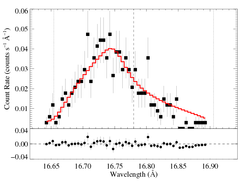
|
[16.64:16.90]
vinf = 2250
β = 1
powerlaw continuum, n = 2; norm = 2.20e-3
q = 0
hinf = 0.5 (frozen)
taustar = 3.59 +/- (2.72:4.52)
Ro = 1.35 +/- (1.04:1.63)
norm = 2.39e-4 +/- (2.28e-4:2.58e-4)
C = 174.08 for N = 308
|
hinf = 1
MEG
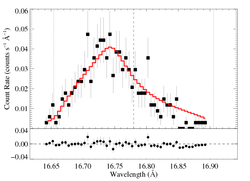
|
[16.64:16.90]
vinf = 2250
β = 1
powerlaw continuum, n = 2; norm = 2.20e-3
q = 0
hinf = 1.0 (frozen)
taustar = 4.38 +/- (3.32:5.49)
Ro = 1.42 +/- (1.25:1.63)
norm = 2.43e-4 +/- (2.28e-4:2.58e-4)
C = 173.24 for N = 308
|
Note: with hinf = 1, taustar has increased by 46 percent.
hinf = 2
MEG
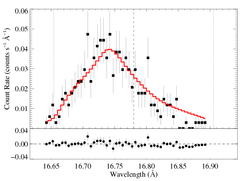
|
[16.64:16.90]
vinf = 2250
β = 1
powerlaw continuum, n = 2; norm = 2.20e-3
q = 0
hinf = 2.0 (frozen)
taustar = 6.52 +/- (4.77:8.51)
Ro = 1.48 +/- (1.37:1.65)
norm = 2.40e-4 +/- (2.28e-4:2.59e-4)
C = 172.60 for N = 308
|
hinf = 5
MEG
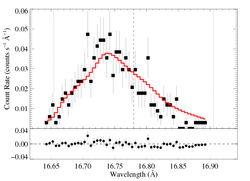
|
[16.64:16.90]
vinf = 2250
β = 1
powerlaw continuum, n = 2; norm = 2.20e-3
q = 0
hinf = 5.0 (frozen)
taustar = 17.88 +/- (11.88:24.40)
Ro = 1.60 +/- (1.49:1.74)
norm = 2.43e-4 +/- (2.29e-4:2.60e-4)
C = 176.26 for N = 308
|
None of the isotropic porosity models can be rejected, not even the hinf = 5 one, although it leads to unrealistically high taustar values.
Confidence limits in taustar-hinf parameter space
The formal constraints here are not tight, although the increase of taustar as hinf is clearly visible. Note also that hinf = 0 is ruled out at only slightly more than the 68% confidence level.
Details of the fitting are in the xspec log.
8.421 Angstroms: Ne X
Non-porous
MEG
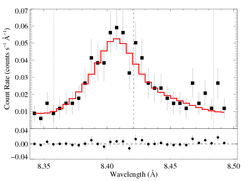
HEG

|
[8.34:8.50]
vinf = 2250
β = 1
powerlaw continuum, n = 2; norm = 1.65e-3
q = 0
hinf = 0
taustar = 1.22 +/- (0.78:2.00)
Ro = 1.34 +/- (1.13:1.51)
norm = 2.94e-5 +/- (2.72e-5:3.18e-5)
C = 186.50 for N = 188
|
The XMM RGS has very low sensitivity at these short wavelengths, and this line is barely detected in it.
Anisotropic porosity
When the porosity length is treated as a free parameter, hinf=0 was preferred, with the non-porous fit parameters recovered (i.e. the data do not favor anisotropic porosity).
hinf = 0.5
MEG
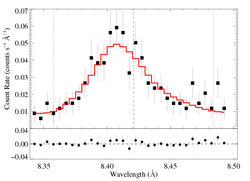
HEG
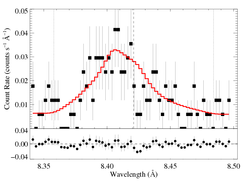
|
[8.34:8.50]
vinf = 2250
β = 1
powerlaw continuum, n = 2; norm = 1.65e-3
q = 0
hinf = 0.5 (frozen)
taustar = 1.72 +/- (0.91:2.49)
Ro = 1.37 +/- (1.23:1.54)
norm = 2.81e-5 +/- (2.73e-5:3.21e-5)
C = 189.80 for N = 188
|
hinf = 1
MEG
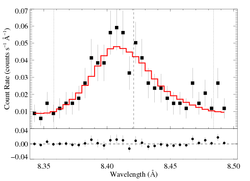
HEG
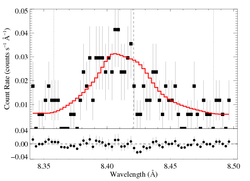
|
[8.34:8.50]
vinf = 2250
β = 1
powerlaw continuum, n = 2; norm = 1.65e-3
q = 0
hinf = 1.0 (frozen)
taustar = 1.46 +/- (0.86:3.04)
Ro = 1.45 +/- (1.29:1.59)
norm = 3.05e-5 +/- (2.72e-5:3.23e-5)
C = 191.52 for N = 188
|
hinf = 2
MEG
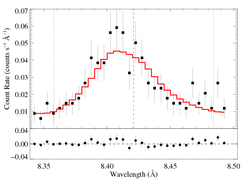
HEG
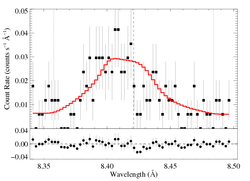
|
[8.34:8.50]
vinf = 2250
β = 1
powerlaw continuum, n = 2; norm = 1.65e-3
q = 0
hinf = 2.0 (frozen)
taustar = 1.83 +/- (0.88:3.91)
Ro = 1.49 +/- (1.37:1.62)
norm = 2.98e-5 +/- (2.74e-5:3.21e-5)
C = 194.13 for N = 188
|
hinf = 5
MEG

HEG
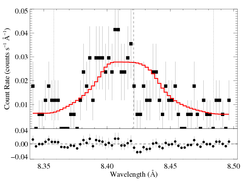
|
[8.34:8.50]
vinf = 2250
β = 1
powerlaw continuum, n = 2; norm = 1.65e-3
q = 0
hinf = 5.0 (frozen)
taustar = 2.37 +/- (0.89:8.56)
Ro = 1.54 +/- (1.42:1.69)
norm = 2.97e-5 +/- (2.74e-5:3.21e-5)
C = 198.61 for N = 188
|
The anisotropic porosity fits are worse than the non-porous fits, but not hugely -- even the hinf = 5.0 fit has only a ΔC ~ 12 (this is relatively significant, at something like 99.9%). Note that the associated taustar values also aren't all the high, though this is a short wavelength, low-taustar line to begin with.
Isotropic porosity
When hinf is allowed to be free, a best-fit value of zero is found, indicating the non-porous models are favored.
hinf = 0.5
MEG

HEG
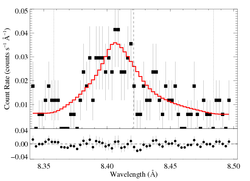
|
[8.34:8.50]
vinf = 2250
β = 1
powerlaw continuum, n = 2; norm = 1.65e-3
q = 0
hinf = 0.5 (frozen)
taustar = 1.31 +/- (0.83:2.05)
Ro = 1.38 +/- (1.20:1.52)
norm = 3.00e-5 +/- (2.71e-5:3.19e-5)
C = 186.83 for N = 188
|
hinf = 1
MEG
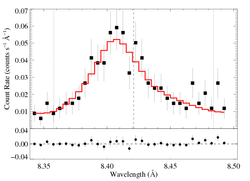
HEG
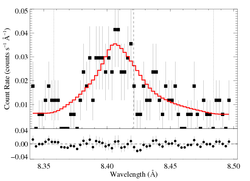
|
[8.34:8.50]
vinf = 2250
β = 1
powerlaw continuum, n = 2; norm = 1.65e-3
q = 0
hinf = 1.0 (frozen)
taustar = 1.46 +/- (0.88:2.39)
Ro = 1.39 +/- (1.24:1.53)
norm = 3.00e-5 +/- (2.72e-5:3.19e-5)
C = 187.12 for N = 188
|
Note: with hinf = 1, taustar has increased by 20 percent.
hinf = 2
MEG
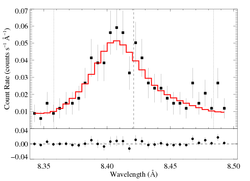
HEG
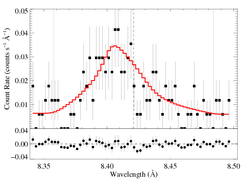
|
[8.34:8.50]
vinf = 2250
β = 1
powerlaw continuum, n = 2; norm = 1.65e-3
q = 0
hinf = 2.0 (frozen)
taustar = 1.79 +/- (0.99:3.21)
Ro = 1.41 +/- (1.29:1.55)
norm = 3.00e-5 +/- (2.72e-5:3.20e-5)
C = 187.73 for N = 188
|
hinf = 5
MEG
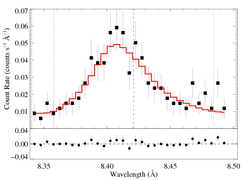
HEG
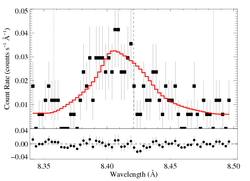
|
[8.34:8.50]
vinf = 2250
β = 1
powerlaw continuum, n = 2; norm = 1.65e-3
q = 0
hinf = 5.0 (frozen)
taustar = 3.19 +/- (1.35:7.52)
Ro = 1.47 +/- (1.37:1.59)
norm = 3.01e-5 +/- (2.73e-5:3.21e-5)
C = 189.74 for N = 188
|
The isotropic porosity fits are only a little worse than the nonporous fit.
Confidence limits in taustar-hinf parameter space
The formal constraints here are not very significant.
Details of the fitting are in the xspec log.
Back to the top
last modified: 29 May 2012
